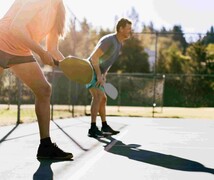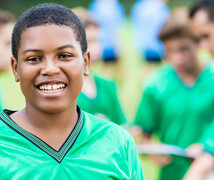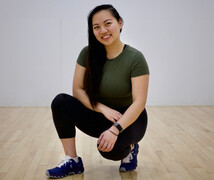If there’s one thing 13-year-old Mike Greeson is passionate about, it’s soccer. So when a mid-game collision with another player left him with a torn ACL, he was worried about his prospects. Often, young athletes are advised to wait on ACL surgery until their growth is complete. Fortunately, his father knew about the soccer experts at Duke Health and took Mike to see a Duke orthopaedic surgeon who specializes in repairing ACL tears in children and adolescents. Today Mike is in recovery and well on his way back to the soccer field.
Sidelined from the Sport He Loves
Mike has been playing soccer since age three and spent many weekends playing back-to-back games. That changed at an out-of-state tournament in early 2021 when he was 12. Mike was knocked to the ground by another player after he pivoted to stop the ball. Watching from the sidelines, John Greeson, Mike’s father, grew concerned when Mike couldn’t get up. He was carried off the field to see the trainer, who told him to ice his swollen knee and rest so he could play in the next game. That didn’t happen. During warmups, his leg buckled under him, and he was sidelined for the rest of the weekend.
Specialized Care for Soccer Athletes
Greeson was eager to get his son treated as soon as possible. When they returned to their home in Hillsborough, NC, he called Duke Health, where Mike’s older sister, also a soccer player, was receiving physical therapy. Greeson knew Duke is a FIFA Center of Excellence and that Duke orthopaedic specialists are experts in treating injuries in soccer players.
At Duke, Mike was diagnosed with a torn anterior cruciate ligament (ACL), which would require surgery to repair. According to Brian Lau, MD, a sports medicine orthopaedic surgeon at Duke Health, this injury is much more common in young athletes than it was 10 or 15 years ago. “The hyper-specialization of sports that's happening younger and younger in kids is increasing the risk of injuries such as ACL tears. They're not playing other sports, and youth sports in general are becoming much more competitive, so kids are playing harder and longer year-round.”
Duke Offers ACL Surgery for Growing Athletes
Historically, children with a torn ACL were encouraged to wait until they finished growing before having ACL surgery. That’s because the procedure can disturb growth plates -- areas of developing cartilage near the ends of long bones -- and potentially affect growth. It might make an injured limb slightly shorter, for example.
“We wanted to avoid disrupting Mike’s growth plates, but we didn’t want to wait on surgery,” Dr. Lau said. “The instability of his knee joint made him more prone to meniscus or cartilage injury. We now understand that children and adolescents with ACL tears who need surgery need it early to stabilize the knee, particularly if we want to keep them active.”
Instead of typical ACL reconstruction in which tunnels are created across two main growth plates near the knee, Mike’s April 2021 surgery was tailored for his growing body. Dr. Lau used a tissue graft from Mike’s iliotibial band to restore stability to his knee, avoiding his growth plates altogether. Not all centers offer this approach -- formally called physeal sparing surgery. “The surgery that he had is not something that every surgeon does. When we learned Dr. Lau had an expertise in treating younger patients with ACL reconstructions, we felt comfortable,” said Greeson.
A Carefully Planned Recovery
After successful surgery, the hardest part of the experience for the active middle school student was recovery. Mike used a walker in the weeks after surgery and participates in weekly physical therapy sessions, an essential part of treatment for people like Mike. In his case, he's working with therapists who specialize in soccer injury treatment and prevention, said Dr. Lau.
Five months after surgery, Mike is lifting weights and performing focused exercises to regain his strength. He also practices with his school’s cross-country team and hopes to compete soon. While it’s not always easy, he’s learned that taking the cautious approach is smart. Mike’s father agrees. “The doctors and therapists do a good job helping him understand not only what he needs to do, but why -- why it's important, and how that translates later on to the field.”
Back in the Game
“I expect Mike to have a 100% recovery,” said Dr. Lau. Before Mike gets the green light to play, he has to pass a test developed at Duke. It measures strength, function, and what doctors call adaptive proprioception. “In an exam room his ACL may feel great, but we want to know what it’s like when he gets on the field, when he gets a little fatigued. We collect objective data to show when he's safe to go back.”
A couple of years later, Mike has made a full recovery and is back to full soccer. He has been followed closely to make sure that he continues to excel and not have any long-term effects of his growth plate. He will be followed until he is fully skeletally mature. Dr. Lau says “It’s important to us that we not only make sure you get back to the field but also that you successfully stay on the field.”




